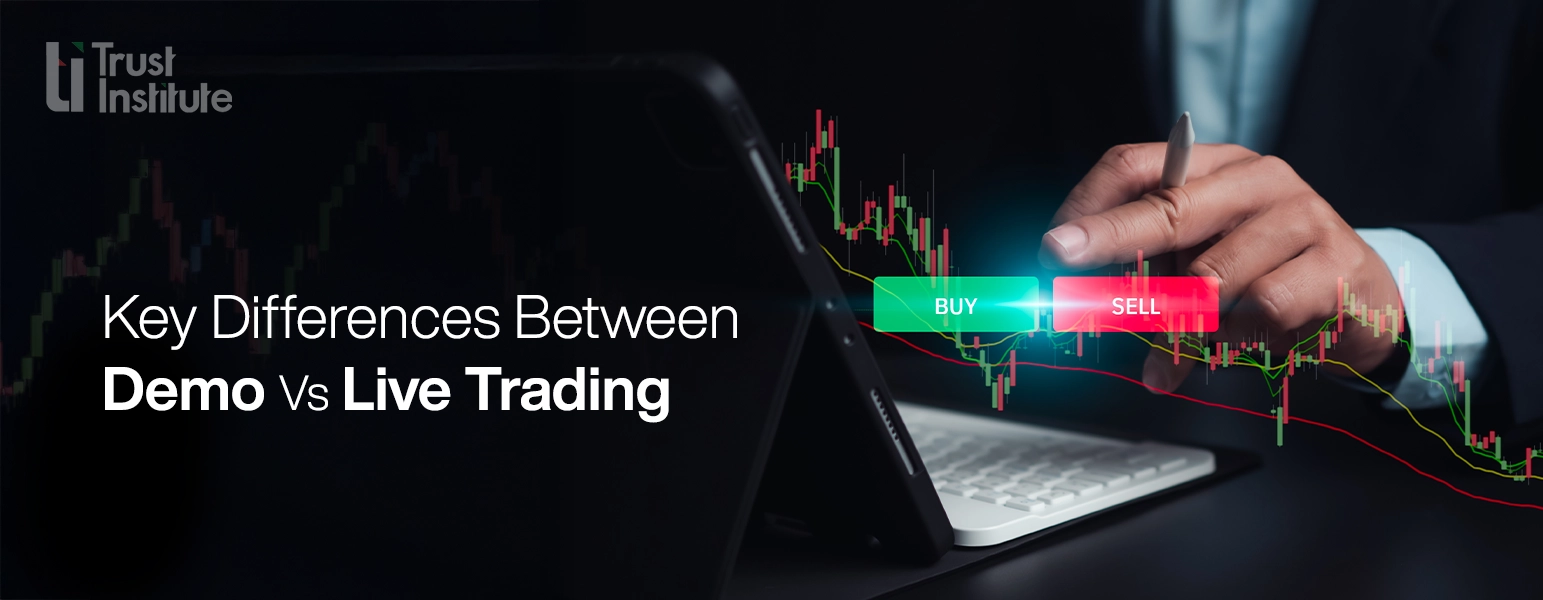Explore the world of financial trading and
gain the knowledge and tools for success with our expertly
written articles and blogs.

HOW TO USE DEMO ACCOUNTS TO IMPROVE YOUR TRADING SKILLS

Most traders dive into the markets headfirst, no practice, no plan, just raw hope and a prayer. That’s a one-way ticket to the poorhouse. Enter the demo account, the closest thing traders get to a free ride, a sandbox where they can swing big, crash hard, and walk away with their real cash still in their pocket. Used right, it’s a game-changer for sharpening skills without the scars.
This blog is going to explain the nitty-gritty of demo accounts and why they matter.
What’s a Demo Account, Anyway?
Picture this: a trading platform hands you a stack of fake money, could be $10,000, could be $100,000, and says, “Go nuts.” That’s a demo account in a nutshell. It’s a mirror of the real market, same charts, same ticks, same gut-wrenching dips, but the cash ain’t yours, and the losses don’t sting. Brokers dish these out like free samples at a deli, letting you test their setups, poke around, and trade everything from stocks to forex to crypto without risking a dime.
What’s the catch? It’s not real. No sweaty palms when a trade tanks, no champagne when you nail a winner. But that’s the beauty, it’s a proving ground, a place to stumble and figure out what works before the real wolves come sniffing.
Why Bother With Fake Money?

Ask any trader who’s blown up an account, and there’s plenty of them, and they’ll tell you that the market don’t care about your feelings. It’s a meat grinder, and newbies are the sausage. Demo accounts flip that script. They’re the gym where you pump iron before stepping into the ring. Here’s why they’re gold.
- No Blood, No Tears: Screw up a trade, and your rent’s still covered. It’s all Monopoly money.
- Learn the Tools: Platforms like Meta Trader can feel like a spaceship cockpit, demos let you fiddle with the buttons ‘til it clicks.
- Test the Waters: Wanna trade forex at 3 a.m. or short some meme stock? Go for it, no consequences.
- Build a Spine: Even fake trades teach you to stomach the rollercoaster without puking
Setting Up the Demo Account.
Grabbing a demo account’s easier than ordering takeout. Leading brokers like Trust Capital slap a “Try Demo” button right on their homepage. Sign up with an email, maybe a fake name if you’re paranoid, and boom, you’re in. They’ll toss you a pile of virtual dough and let you loose.
Don’t just start clicking like a kid with a new toy. Poke around. Check the charts, can you tweak ‘em? Mess with indicators, RSI, MACD, whatever sounds cool.
Start Small & Humble
Here’s where most folks trip, they log in, see $50,000 in play money, and start swinging like they’re Gordon Gekko on a bender. Instead of that, treat that fake cash like it’s your last paycheck. Start small, tiny trades, low leverage, baby steps. Because the habits you build here stick when the stakes get real.
Cook Up a Plan and Stick to It

Trading without a plan’s like driving blindfolded, you might get lucky, but odds are you’ll hit a tree. Demo accounts are where you hammer out a strategy. Maybe it’s scalping, sniping quick profits on little wiggles. Or swing trading, riding a wave for a few days. Whatever it is, write down entry points, exits and how much you’ll risk. Make it dumb-simple, three rules max.
Then stick to it like glue. Place a trade when your setup screams “go,” not ‘cause you’re bored. If it flops, tweak the plan, not your temper. The demo’s forgiving, real markets are not.
Mimic the Real Deal
Demo trading can feel like a video game, too easy, too chill. To toughen up, make it real as hell without the cash. Set a daily limit, say, $100 of fake losses, and quit if you hit it. Time your trades like you’ve got a boss breathing down your neck. Crank the leverage to see how fast a bad call can torch you.
Train your gut to handle the shakes. Real trading is a pressure cooker, demo’s your chance to build calluses.
Know When to Pull the Plug

Demo accounts are not forever. Stay too long, and you get cocky, fake wins puff you up, but real losses hit differently. Once the basics click, platform’s smooth, plan’s solid, nerves are steady, and jump to real trades. Start tiny, a $100 account, micro-lots, whatever keeps the stakes low. The demo is a crutch, kick it when you can walk.
One vet swore he demoed for six months, crushing it, then lost half his live cash in a week. Why? Real fear messed him up. Switch when you’re sharp, not smug.
Pitfalls to Dodge
Demo is a gift, but it’s got traps. No emotions, fake losses don’t hurt, so you might trade dumber than you would live. Brokers juice demos too, tight spreads, fast fills you won’t see later. And time? Waste a year playing pretend, and you’re just stalling. Use it hard, use it smart, then get out.
Leverage Skills That Stick
Done right, demo accounts forge traders like steel. They teach discipline, sticking to a plan when chaos hits. They sharpen eyes, spotting setups in the noise. They toughen guts, riding swings without blinking. As a rookie you can use a demo for three months, lose big, win bigger, and then can go live with $500. A year later, you can see yourself up 30%.
Markets don’t mess around, demo accounts do. They’re the sparring ring before the title fight, the dry run before the heist. No one’s born a trader, they’re made, one fake buck at a time.
Wrapping Up
Trading is a brutal gig, half art, half war, all hustle. Demo accounts hand you a shot to learn the ropes without bleeding cash. They’re not sexy, they’re not real, but they’re damn useful. Set one up, grind it out, screw up, and grow. The market’s waiting, and it don’t play nice, better show up ready.
All blogs
©TRUST TRAINING AND DEVELOPMENT INSTITUTE 2025
Disclaimer: Trust Institute is a KHDA-licensed educational institution based in Dubai, UAE. All training programs, materials, and content offered through our website and in-person sessions are provided strictly for educational purposes. We do not offer financial or investment advice, and we do not engage in or promote any trading activity.
Our courses are designed to increase knowledge and understanding of financial markets. Trust Institute is not a brokerage firm, does not manage client funds, and does not participate in any trading on behalf of its students.
Participation in financial markets, including Forex trading, involves significant risk and may not be suitable for everyone. Individuals are encouraged to conduct their own research and consult with licensed financial professionals before making any financial decisions.
By accessing our content or enrolling in our courses, you acknowledge and accept that Trust Institute is not liable for any financial outcomes resulting from the application of educational material shared. You agree that your use of this information is at your own discretion and responsibility.
Trust Institute is fully licensed and regulated by the Knowledge and Human Development Authority (KHDA) in Dubai, United Arab Emirates.











































